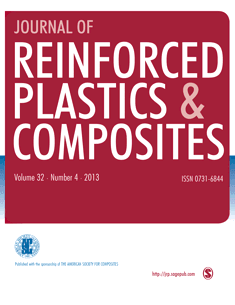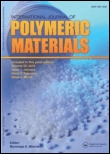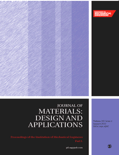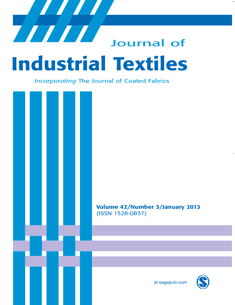
International Journal of Smart and Nano Materials
Scope & Guideline
Unlocking Potential through Innovative Material Science
Introduction
Aims and Scopes
- Smart Materials Development:
Research on materials that can respond to external stimuli (e.g., temperature, light, electric fields) and exhibit adaptive behaviors, such as shape memory alloys and self-healing materials. - Nanomaterials and Nanotechnology:
Exploration of materials at the nanoscale, including their synthesis, characterization, and applications in various fields such as electronics, biomedicine, and energy. - Advanced Fabrication Techniques:
Innovative methodologies for the fabrication and processing of smart and nano materials, including 3D printing, electrospinning, and advanced lithography. - Interdisciplinary Applications:
Focus on the application of smart and nano materials in diverse fields such as flexible electronics, biomedical devices, environmental remediation, and energy systems. - Mechanical and Structural Performance:
Investigation of the mechanical properties and performance of new materials, including studies on stress, strain, and failure mechanisms.
Trending and Emerging
- Liquid Metal Applications:
There is a growing interest in the application of liquid metals in flexible electronics and energy systems, highlighting their unique properties and potential for innovative uses. - Hydrogels and Biocompatibility:
Research on hydrogels, especially those mimicking biological tissues for medical applications, has gained traction, emphasizing their importance in biomedical engineering. - Integration of Machine Learning:
The integration of machine learning techniques in material design and analysis is emerging as a significant trend, enhancing predictive capabilities and optimizing material performance. - Energy Harvesting Technologies:
The development of energy harvesting devices, particularly those utilizing triboelectric and piezoelectric principles, is increasingly featured, reflecting a focus on sustainability and self-powered systems. - Bioinspired Materials and Structures:
There is a notable trend towards designing materials and structures inspired by biological systems, which offer innovative solutions and enhanced functionalities in various applications.
Declining or Waning
- Traditional Composite Materials:
Research on conventional composite materials has decreased, as the focus shifts towards more advanced smart materials and nanocomposites that offer superior performance. - Static Mechanical Properties:
Studies primarily focused on static mechanical properties without dynamic or smart applications are less frequently published, indicating a trend towards dynamic and responsive material behavior. - Basic Synthesis Methods:
Basic synthesis techniques that do not incorporate innovative or advanced methodologies are becoming less common, as researchers seek novel approaches that enhance material functionality. - Conventional Sensors:
The development and analysis of traditional sensor technologies are waning in favor of more advanced, integrated sensor systems that leverage smart materials and nanotechnology. - Standardized Testing Protocols:
Research centered on conventional testing methods is declining, with a growing emphasis on innovative testing techniques that better evaluate the performance of advanced materials.
Similar Journals

ADVANCED ENGINEERING MATERIALS
Exploring the Frontiers of Material InnovationADVANCED ENGINEERING MATERIALS is a leading journal dedicated to the field of materials science, particularly within the realm of condensed matter physics. Published by WILEY-V C H VERLAG GMBH in Germany, this esteemed journal has been a crucial platform for disseminating cutting-edge research since its inception in 1999. With an impressive impact factor and ranked in the top quartiles of its categories, it boasts a Q1 ranking in Condensed Matter Physics and a Q2 rank in related materials science fields as of 2023. ADVANCED ENGINEERING MATERIALS serves a diverse readership, including researchers, industry professionals, and students, striving to advance the understanding and application of innovative materials. Frequent contributions to this journal help bridge theoretical advancements with practical applications, fostering a vibrant academic and industrial dialogue. Although currently not an open-access journal, the insights shared within its pages are pivotal for anyone engaged in the dynamic sectors of engineering and material sciences.

JOURNAL OF REINFORCED PLASTICS AND COMPOSITES
Unveiling Breakthroughs in Composite MaterialsWelcome to the JOURNAL OF REINFORCED PLASTICS AND COMPOSITES, a leading publication in the realms of materials science, engineering, and polymers. Published by SAGE Publications Ltd, this journal stands out with its robust Q2 ranking in multiple categories, including Ceramics and Composites, Materials Chemistry, Mechanical Engineering, and Mechanics of Materials. Since its inception in 1982, the journal has become an essential resource for researchers and professionals, disseminating pioneering research and innovative applications in reinforced plastics and composite materials. Though not open access, subscribers gain exclusive insights into groundbreaking findings contributing to the advancement of the industry. The journal is indexed in Scopus, with notable rankings that reflect its influence and high-quality scholarship. With ongoing coverage until 2024, the JOURNAL OF REINFORCED PLASTICS AND COMPOSITES remains committed to fostering academic dialogues and facilitating advancements in sustainable materials and advanced engineering solutions.

Materia-Rio de Janeiro
Fostering collaboration for impactful scientific discoveries.Materia-Rio de Janeiro is a distinguished open-access journal published by UNIV FED RIO DE JANEIRO, LAB HIDROGENIO, dedicated to advancing knowledge in the fields of Chemistry, Materials Science, and Physics. Since its inception in 2006, the journal has established a platform for the dissemination of innovative research, fostering collaboration among researchers globally. The journal's commitment to open access promotes the widespread availability of valuable scientific findings, making it an essential resource for academia and industry professionals alike. With a focus on diverse disciplines, Materia-Rio de Janeiro holds a Q4 classification in multiple categories for 2023, indicating its relevance in the expansive landscape of materials research. Operating from Rio de Janeiro, Brazil, this journal serves as a vital conduit for emerging scientific insights, hence delivering impactful contributions to the global research community.

International Journal of Polymeric Materials and Polymeric Biomaterials
Advancing Research in Polymeric InnovationsThe International Journal of Polymeric Materials and Polymeric Biomaterials, published by Taylor & Francis AS, stands at the forefront of materials science, showcasing groundbreaking research in the fields of Analytical Chemistry, Chemical Engineering, and Polymeric Materials. With an ISSN of 0091-4037 and an E-ISSN of 1563-535X, this esteemed journal, established in 1971, serves as a vital platform for academics and professionals seeking to disseminate innovative findings and elevate the understanding of polymeric materials. Featuring a commendable impact factor and ranking in the top quartiles of its categories—Q2 in Analytical Chemistry, Chemical Engineering, and Polymers and Plastics—the journal is a pivotal resource for researchers aiming to leverage polymer science in various applications. Although it does not offer open access, its rigorous peer-review process ensures that only high-quality research is published, making it an essential reference for anyone involved in polymer research and development.

University Politehnica of Bucharest Scientific Bulletin Series B-Chemistry and Materials Science
Connecting Ideas, Transforming Materials ScienceUniversity Politehnica of Bucharest Scientific Bulletin Series B-Chemistry and Materials Science is a renowned academic journal published by POLYTECHNIC UNIV BUCHAREST, situated in Romania. With the ISSN 1454-2331, this journal serves as a dynamic platform for the dissemination of innovative research findings in the fields of chemistry and materials science. Although classified in the Q4 quartile of both Chemistry (miscellaneous) and Materials Science (miscellaneous) categories for 2023, it has made a significant impact by providing a venue for emerging scholars and established researchers alike to share their work. The journal seeks to bridge theoretical insights and practical applications, promoting interdisciplinary dialogue and advancing scientific understanding. The scope encompasses a broad range of topics, reflecting contemporary advancements and challenges within the field. To facilitate access to its articles, while it does not currently operate under an open-access model, the journal remains committed to enhancing visibility through digital libraries. With a publication history spanning from 1999 to 2024, the journal is vital for all stakeholders—researchers, professionals, and students—seeking to stay abreast of developments in chemistry and materials science.

Discover Nano is a pioneering journal published by SPRINGER, dedicated to the rapidly evolving field of nanoscience and nanotechnology. Established in 2023, this innovative platform provides an open-access forum for researchers, professionals, and students to share and disseminate cutting-edge findings in materials science and condensed matter physics. With its commitment to accessibility, Discover Nano encourages a broad spectrum of contributions, aiming to foster collaboration and stimulate discussion in this dynamic area of study. As a new entry into the academic community, the journal holds great potential for growth, aspiring to increase its visibility and impact in the materials science arena, where it currently ranks in the bottom quartile for both materials science and physics categories. Based in Germany and reaching a global audience, Discover Nano represents a significant opportunity for those looking to shape the future of nanotechnology through impactful research and interdisciplinary dialogue.

PROCEEDINGS OF THE INSTITUTION OF MECHANICAL ENGINEERS PART L-JOURNAL OF MATERIALS-DESIGN AND APPLICATIONS
Advancing Innovation in Materials Design and EngineeringPROCEEDINGS OF THE INSTITUTION OF MECHANICAL ENGINEERS PART L-JOURNAL OF MATERIALS-DESIGN AND APPLICATIONS is a prestigious academic journal published by SAGE PUBLICATIONS LTD, focusing on the dynamic fields of mechanical engineering and materials science. With an impressive impact factor reflective of its rigorous scholarly contributions, this journal serves as a vital platform for the dissemination of innovative research and practical applications in materials design and engineering processes. Since its inception in 1999 and continuing through 2024, it has maintained a robust reputation, achieving a Q2 ranking in both Materials Science (miscellaneous) and Mechanical Engineering categories, as well as commendable Scopus ranks that place it in the top percentiles of its fields. Located in the United Kingdom, the journal encourages submissions from researchers and professionals who are seeking to advance their understanding of materials applications while fostering interdisciplinary collaboration. Although it currently operates under traditional access terms, the journal prioritizes impactful research that addresses contemporary challenges in design and manufacturing, ensuring that it remains a must-read for anyone invested in the innovations shaping our technological landscape.

Journal of Industrial Textiles
Unveiling Sustainable Practices in Textile ScienceJournal of Industrial Textiles, published by SAGE Publications Inc, is a leading academic journal that focuses on the intricate interplay between textile materials and industrial applications. With a significant impact factor and a strong reputation in the field, it caters to a diverse audience ranging from researchers and professionals to students interested in the advancement of textile engineering, chemical engineering, and materials science. The journal offers invaluable insights into innovative textile processes, sustainable practices, and the latest technological developments as it spans research contributions from 1971 to the present. Notably, it ranks in the second quartile across various categories, including Chemical Engineering and Industrial and Manufacturing Engineering, reflecting its influence and quality in the scientific community. Although it is not an open access journal, the Journal of Industrial Textiles remains a critical resource for advancing knowledge and fostering collaboration within the textile sector and related fields.

Nano Materials Science
Pioneering Research in Nano Materials.Nano Materials Science is a premier open-access journal dedicated to the dissemination of groundbreaking research in the fields of nanotechnology, materials science, and chemical engineering. Published by KEAI PUBLISHING LTD, this journal has quickly established itself as a leading platform in its area since its inception in 2019, with impressive rankings in the Scopus database, holding a Q1 position across multiple categories, including Chemical Engineering and Materials Science. Based in Beijing, China, Nano Materials Science provides researchers and practitioners access to a wealth of high-quality peer-reviewed articles, fostering innovation and collaboration within the scientific community. With its impact factor steadily rising and a commitment to open access, the journal aims to bridge the gap between theoretical research and practical applications, making it an essential resource for professionals and students eager to stay at the forefront of materials research and nanotechnology advancements.

FIBERS AND POLYMERS
Advancing the Science of Materials Through InnovationFIBERS AND POLYMERS is a prestigious scholarly journal published by the Korean Fiber Society, specializing in the fields of Chemical Engineering, Chemistry, and Polymer Science. Since its inception in 2000, the journal has provided a dynamic platform for researchers and professionals to disseminate cutting-edge findings and innovative methodologies related to fibers, polymers, and their diverse applications. With its Q2 category ranking across multiple disciplines in 2023 and a commendable standing in Scopus rankings—ranking #183 in General Chemistry and #127 in General Chemical Engineering—it is well-regarded within the academic community. The journal’s commitment to quality research is further underscored by its comprehensive coverage of technological advancements and theoretical developments relevant to both industry and academia. Access to published articles may vary, and authors are encouraged to submit original research to contribute to this evolving field. Join the community shaping the future of materials science through FIBERS AND POLYMERS.